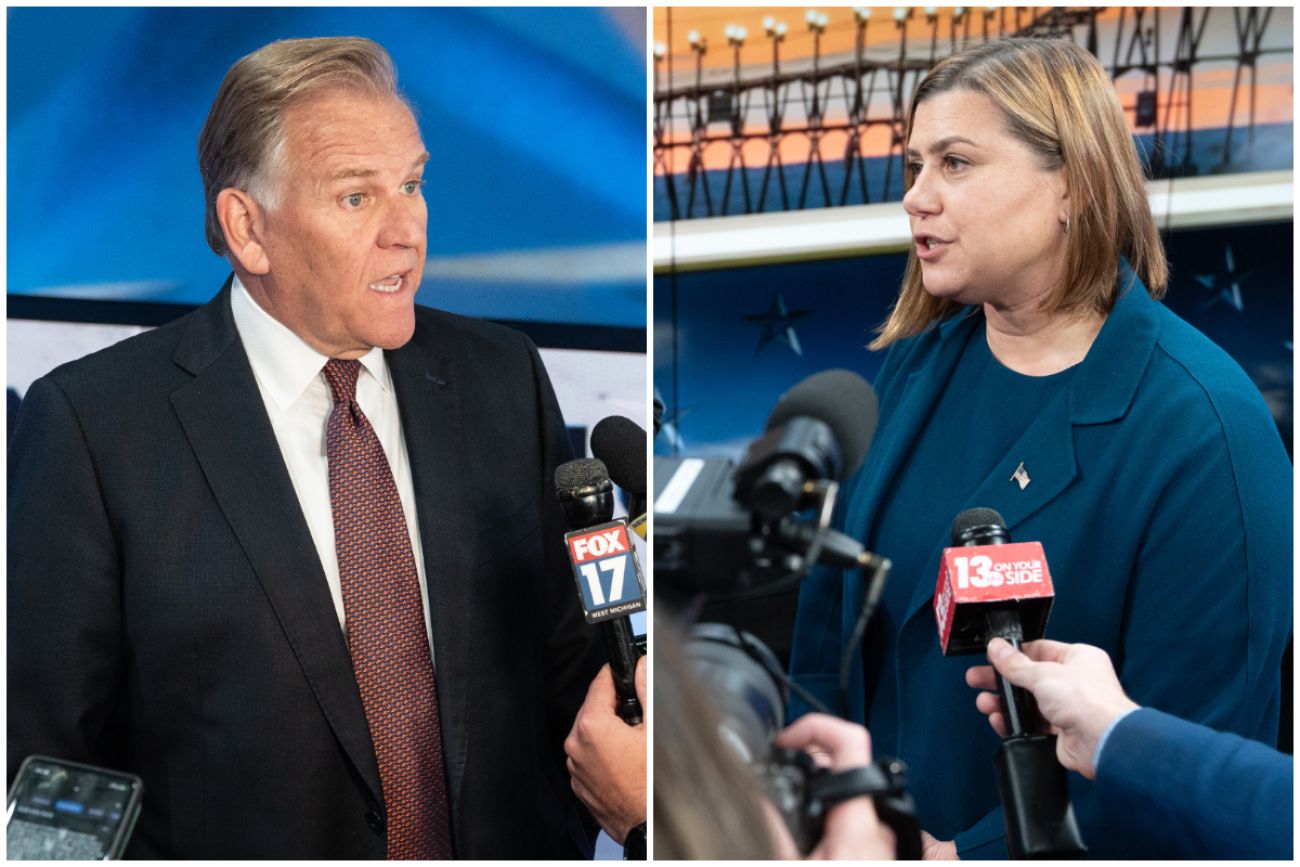Democrats have cash advantage in key Michigan races. GOP claims momentum

- Democrats had the fundraising advantage over Republicans during the last filing period in Michigan’s closest congressional races
- U.S. Senate candidate Elissa Slotkin raised nearly four times as much as Republican rival Mike Rogers, who is gaining in polls
- U.S. House races in the 7th, 8th, 3rd and 10th congressional districts remain close, even if some of the fundraising has been lopsided
LANSING — In the battle for Michigan representation in Washington, Democratic candidates have outraised their Republican counterparts in some of the state’s most competitive contests, but many remain too close to call.
With mail-in voting already underway and the Nov. 5 election fast approaching, campaign advertising is nearly impossible to ignore. But it’s not yet clear if this year’s races will eclipse the record $500 million spent in Michigan four years ago.
As of the start of October, Michigan’s U.S. Senate candidates had raised less than their counterparts in 2020, even as spending from outside groups was more or less on par with that election.
And while the state has some of the closest U.S. House races in the country, none seems close to equaling the nearly $30 million spent in 2018’s 8th Congressional District race.
Still, hundreds of millions of dollars will be raised and spent in Michigan this year by candidates and outside groups. Here is a look at where those dollars are coming from so far:
U.S. Senate: Slotkin dominates fundraising, Rogers gaining in polls
In the race to replace retiring U.S. Sen. Debbie Stabenow, Democratic U.S. Rep. Elissa Slotkin raised nearly four times as much as her Republican opponent Mike Rogers in the latest reporting period, which ran from July 18 through Sept. 30.
Slotkin raised $16.7 million to Rogers’ $4.2 million for the period, according to federal disclosure reports. That brought Slotkin’s total fundraising since the start of her campaign to $40.7 million and Rogers’ to $9.5 million.
Nearly $6.6 million of Slotkin’s latest haul was from unitemized donations, meaning contributions from donors who gave $200 or less in total this election cycle. About $869,000 of Rogers’ contributions were similarly unitemized.
Related:
- 2024 Michigan elections: Nearly 800,000 votes already cast by absentee ballot
- Kamala Harris, Donald Trump ramp up fight for Michigan in final weeks of campaign
- In Michigan’s north woods, a search for Bigfoot and political common ground
The Holly Democrat spent more than $21 million in the two-and-a-half-month reporting period, compared to less than $4 million spent by her Republican rival, a significant imbalance in a race that is nonetheless considered a toss-up.
The Rogers campaign has claimed "momentum" as surveys suggest he is gaining ground on Slotkin, who has consistently polled better than the Democrat leading the top of the ticket, Vice President Kamala Harris.
Throughout the election cycle, Rogers has had about $10 million more in outside help than Slotkin, with roughly $55 million spent to aid him. The White Lake Township Republican has maintained an edge in outside spending through September and into October.
The seat is considered crucial to GOP hopes of regaining control of the U.S. Senate, where Democrats and independents who caucus with the party currently hold a 51-49 seat majority.
The Senate Leadership Fund and National Republican Senatorial Committee, accounts associated with Senate Minority Leader Mitch McConnell of Kentucky, have together spent more than $26 million attacking Slotkin.
Rogers has been primarily backed by a super PAC called Great Lakes Conservatives Fund. It has spent more than $19 million supporting Rogers and attacking Slotkin this election cycle. Funding for the PAC has come largely from billionaires from outside the Great Lakes region who’ve given six- and seven-figure contributions.
Billionaire Tim Dunn of Texas, who is the PAC’s largest single donor at $5 million, made his fortune in the oil industry. New Yorker and private equity giant Stephen Schwarzman has given $4.5 million. Ken Griffin, a Floridian who founded the hedge fund Citadel, has given $2.5 million.
Two Democratic PACs fighting to preserve the party’s Senate majority have been Slotkin’s largest outside helpers, pouring in a combined $23 million to attack Rogers through the election.
Outside support for Slotkin has been led by Protect Progress, a super PAC formed to support candidates with pro-cryptocurrency views. It has spent about $10 million supporting Slotkin and has also backed Senate candidate Ruben Gallego of Arizona, another Democrat.
Heading into October, Slotkin had a little more than $4 million left in the bank, while Rogers had about $2.6 million.
U.S. House: Hertel outraising Barrett in 7th District
In one of the nation’s closest U.S. House races, Republican former state Sen.Tom Barrett of Charlotte is making his second attempt to win the Lansing-area 7th Congressional District after losing to Slotkin in 2022.
Democrat Curtis Hertel of East Lansing, another former state senator and adviser to Gov. Gretchen Whitmer, raised about $2.3 million and spent roughly $3.4 million during the latest period in a quest to hold the seat for Democrats.
Barrett, on the other hand, raised $1.4 million and spent $1.3 million in the period. Despite the lower fundraising total, Barrett slightly bested Hertel among small-dollar donors who’ve given $200 or less. Those donations made up nearly half of all the money Barrett raised from individuals.
Hertel, however, had more than twice as many individual contributions overall.
In total, Hertel has raised about $6.5 million and spent about $4.3 million for the election cycle. Barrett has raised about $1.4 million and spent $2.9 million. Hertel ended September with $2.2 million in the bank, compared to $1.3 million for Barrett.
Like the U.S. Senate contest, outside spending from super PACs has eclipsed the candidates’ own spending in the 7th Congressional District race. Those PACs, primarily representing each major party’s congressional efforts, have spent $6.6 million to aid Barrett and $6.3 million to aid Hertel.
U.S. House: Junge self funding, McDonald Rivet raising more in 8th District
In Michigan’s competitive 8th Congressional District, Republican Paul Junge of Grand Blanc Township is continuing to pump his own money into the campaign and has now contributed nearly $6 million across three elections, including the two he previously lost.
This year may be Junge’s best chance to win yet, however. The seat is open because of the pending retirement of Democratic Rep. Dan Kildee of Flint, and the district is more conservative than when he first ran in 2020.
Junge contributed nearly $1.9 million of his own money in the latest filing period, but he raised less than $400,000 from other sources, for a total of around $2.2 million in the period.
State Sen. Kristen McDonald Rivet of Bay City, his Democratic opponent, raised more than $2.9 million from donors, more than a fourth of which came from small-dollars donors.
In total, McDonald Rivet has raised about $4.7 million and spent about $3 million for the election cycle. Junge has raised about $4.4 million and spent $4.1 million. McDonald Rivet ended September with $1.6 million in cash reserves, while Junge has just about $440,000 to spend.
In outside help, the candidates have been neck-and-neck, with a little more than $3.6 million behind McDonald Rivet and more than $3.5 million assisting Junge throughout this election cycle.
U.S. House: Marlinga closing gap on James in 10th District
In Michigan’s 10th Congressional District, Republican U.S. Rep. John James of Shelby Township won election two years ago by less than 2,000 votes, a 0.5% margin over Democrat Carl Marlinga of Sterling Heights.
Now amid a rematch, Marlinga fundraised more over the last campaign filing period but was far outspent by James, who had raised more earlier in the cycle.
Marlinga raised about $1.6 million but spent less than $400,000. James raised about $1.3 million but spent more than $2.8 million.
James also bested Marlinga in small-dollar donors and had more than $2.5 million left in the bank heading into October, nearly twice as much as Marlinga.
James, a first-term incumbent, has raised $7.8 million this election cycle and spent nearly $6.3 million of that total. Marlinga, by comparison, has raised $2.2 million in total and spent slightly less than $1 million.
Still, Marlinga has been able to lean on independent spenders to close some of that gap. Outside groups have spent more than $3.8 million to boost Marlinga, primarily by attacking James, while others have spent about $1.8 million to support James. The spending has been funded primarily by each party’s caucus PAC in the House.
U.S. House: Lopsided spending for Scholten in 3rd District
Entering 2024, Michigan’s 3rd Congressional District was initially considered a toss-up, but as the year has progressed the race appears to have titled more in the direction of incumbent Democratic Rep. Hillary Scholten, who has outraised and outspent Republican opponent Paul Hudson by a considerable margin.
Hudson, an East Grand Rapids attorney, first had to endure a challenge from the right against Michael Markey in the Republican primary before turning to face Scholten, in a district that is gradually growing friendlier to Democrats and increasingly sour toward former President Donald Trump.
Scholten, of Grand Rapids, raised close to $1.4 million from mid-July through September, while Hudson raised less than $300,000. She spent close to $2 million in the period, while Hudson spent roughly a fifth of that amount.
A super PAC funded by Hudson’s brother was active in the GOP primary but has so far spent only $27,000 attacking Scholten in the general election. There has been no other reported outside spending in the race, a crucial indicator of the view among insiders of a race’s competitiveness.
Dark Money
While candidates and committees are required to disclose donors and spending, it is nearly impossible to track the full spending of “dark money” groups who advertise heavily in competitive races.
They are largely created as nonprofit organizations and use phrases like “wrong for Michigan” to avoid disclosure requirements that would require them to follow federal election rules and report spending. The adoption of these techniques has been broadly adopted by both liberal and conservative funders.
While some services offer reporting on these organizations' broadcast advertising, other efforts like mailed advertising and door-to-door canvassing can’t readily be tracked.
In the state’s 2020 U.S. Senate election, the nonpartisan Michigan Campaign Finance Network found that dark money groups were some of the largest independent spenders for Democratic incumbent Gary Peters and James, his Republican challenger, in a race where more than $200 million was spent.
See what new members are saying about why they donated to Bridge Michigan:
- “In order for this information to be accurate and unbiased it must be underwritten by its readers, not by special interests.” - Larry S.
- “Not many other media sources report on the topics Bridge does.” - Susan B.
- “Your journalism is outstanding and rare these days.” - Mark S.
If you want to ensure the future of nonpartisan, nonprofit Michigan journalism, please become a member today. You, too, will be asked why you donated and maybe we'll feature your quote next time!





